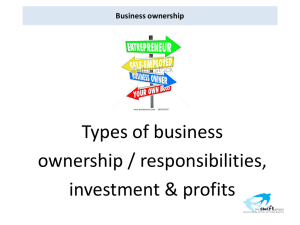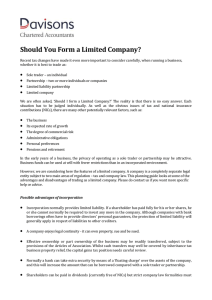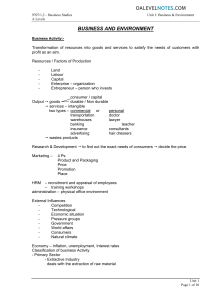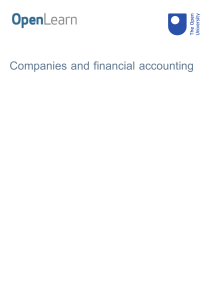Business Ownership Types: Worksheet & Tasks
advertisement
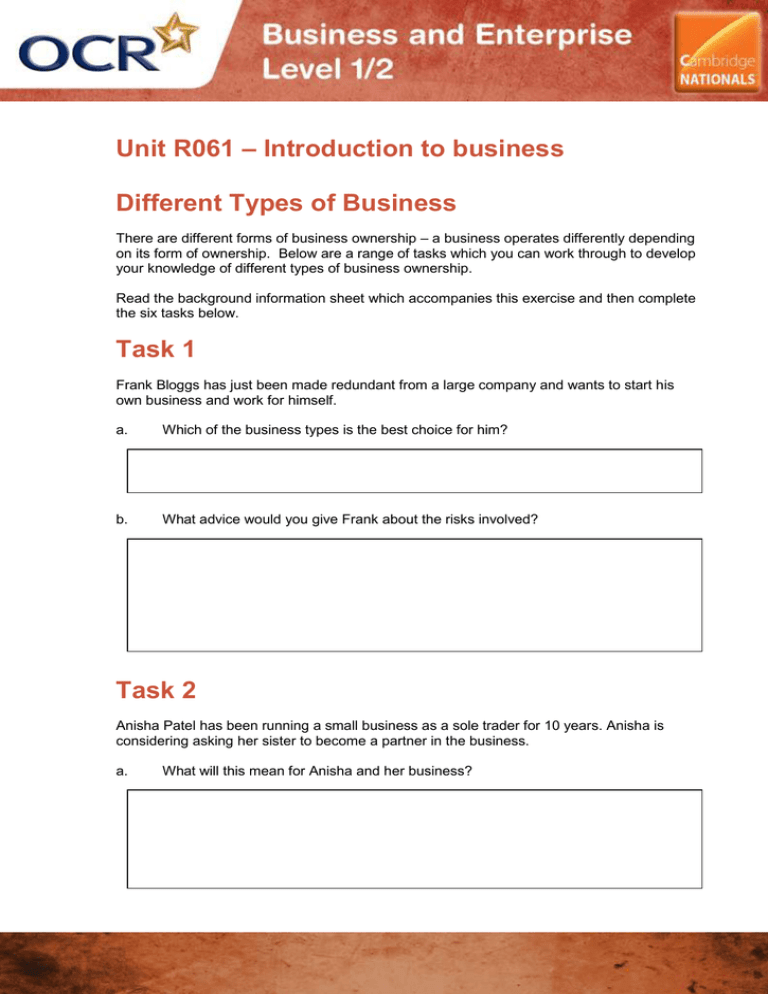
Unit R061 – Introduction to business Different Types of Business There are different forms of business ownership – a business operates differently depending on its form of ownership. Below are a range of tasks which you can work through to develop your knowledge of different types of business ownership. Read the background information sheet which accompanies this exercise and then complete the six tasks below. Task 1 Frank Bloggs has just been made redundant from a large company and wants to start his own business and work for himself. a. Which of the business types is the best choice for him? b. What advice would you give Frank about the risks involved? Task 2 Anisha Patel has been running a small business as a sole trader for 10 years. Anisha is considering asking her sister to become a partner in the business. a. What will this mean for Anisha and her business? b. If her business grows and becomes more successful what other business ownership options does Anisha have? Task 3 Virgin Group Ltd employs 50,000 people across 34 different countries, but is still a private limited company (Ltd). How does one man, Richard Branson, manage to keep control of his company? Task 4 A Public Limited Company (plc) is a business which is owned by shareholders who have bought shares on the stock market. If the business does not create the expected amount of profit how does this affect the shares? Task 5 Complete the following sentences by filling in the blanks using the words from the table below. The in a limited company (plc) can be bought and sold publicly on the stock exchange. However private limited company shares are only traded privately, often between family and friends. A private limited company must have the letters after its name. Where a sole trader converts their business to a private limited company and sells shares to others, the original some level of as they are answerable to Both plc and Ltd companies enjoy limited can lose . , which means that personally shareholders can only lose the money that they have invested in the company. A big difference between a company and a trader is that the company has to pay tax. tax instead of control Corporation income liability Ltd owner public shareholders shares sole Task 6 In the space below, explain the major differences between a sole trader and a private limited company. Background information There are four main types of business: 1. 2. 3. 4. Sole trader Partnership Private Limited Company Public Limited Company Sole trader A sole trader is the easiest type of business to set up, all that is required is to register with the tax office and keep good records to enable the tax to be paid once a year. As well as being the simplest type of business to set up but it is also the most risky. All finance, debt or legal issues are the responsibility of the owner and it may be difficult to get financial backing from external investors. Effectively the owner is the business, so John Smith, trading as JS Trading, is liable for all the work done as well as paying any debts if the business folds. However all the profits belong to the owner, who must then pay personal income tax on that money. Partnership The set up of a partnership is similar to that of a sole trader, however, the business is owned by two or more people. In a partnership each partner has responsibility for the business. This includes finance, legal issues, a share of property and profits. There is usually a ‘Deed of Partnership’ which details rights and responsibilities within the partnership. It is possible to have ‘sleeping partners’, these are people who do not have any part in the day to day running of the business but still share the financial responsibility and profit. Many accountants and solicitors are partnerships. Private Limited Company (Ltd) In a private limited company, ownership liability is limited to the value of the shares in the company. This means that any debts are the company’s debts and not the owners. There is a Director of the company, and the company must keep and declare annual accounts as well as meeting various legal requirements such as registering the business name. These businesses come in various sizes from small family firms to large multinationals businesses, for example Virgin Group Ltd. The majority shareholder retains control of the business but all of the shareholders can have a say in the running of the business. Public Limited Company (plc) A plc also has shares but these can be owned by anyone and are bought and sold through the stock market. The business is owned by the shareholders who receive a share of the profits, and it is managed by the Board of Directors. The business must produce annual reports and accounts, which are accessible to the public, and have at least two directors and a qualified company secretary. These activities offer an opportunity for English skills development.





